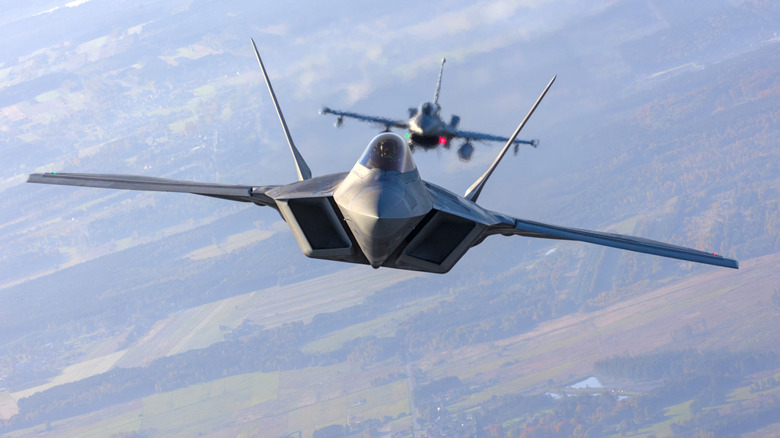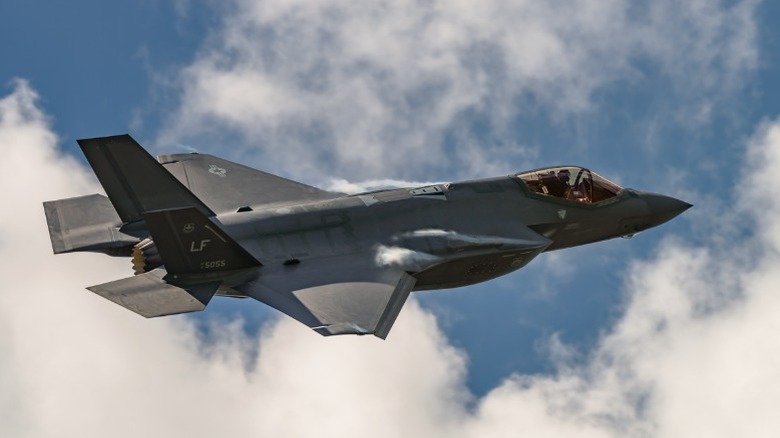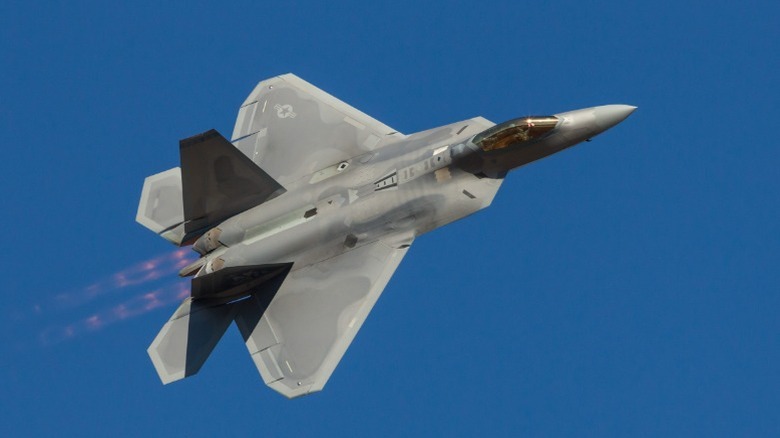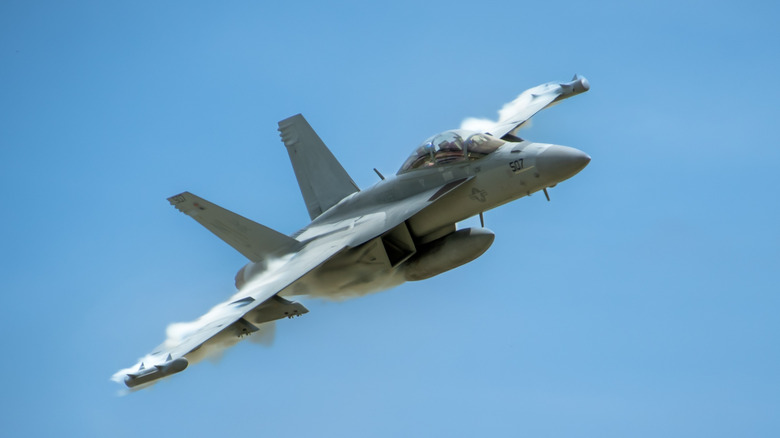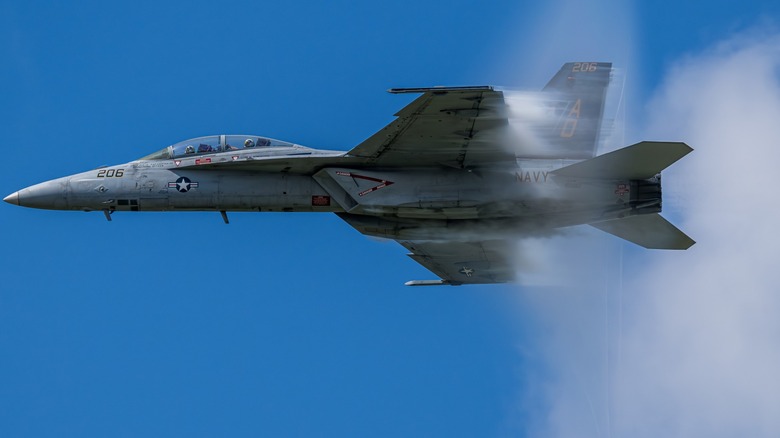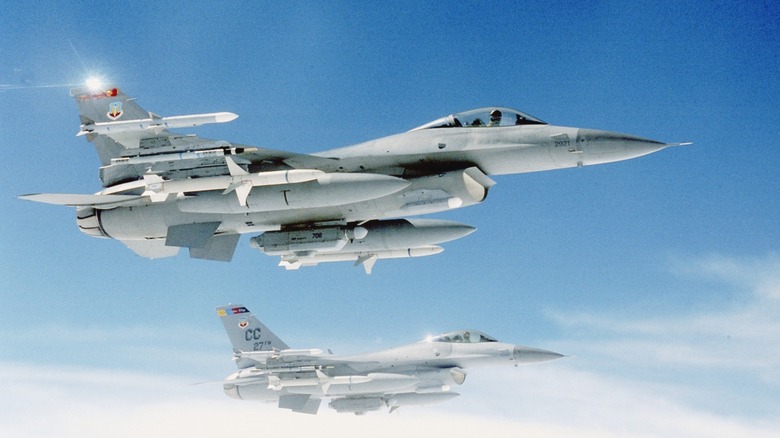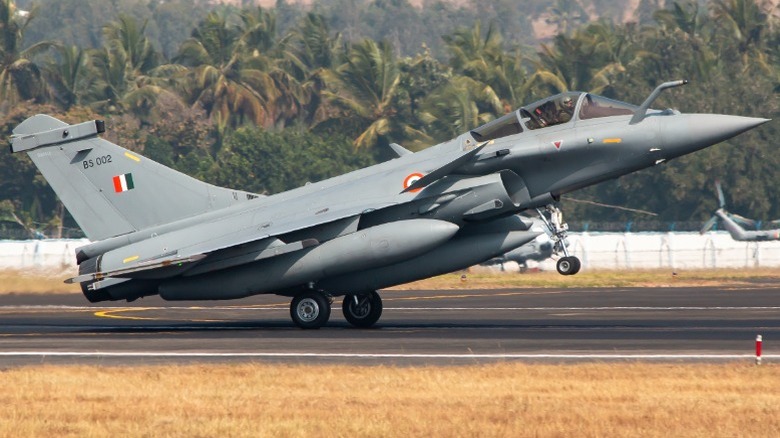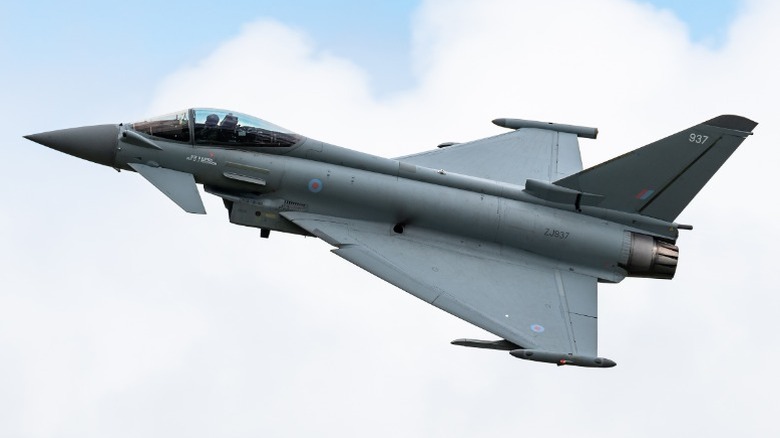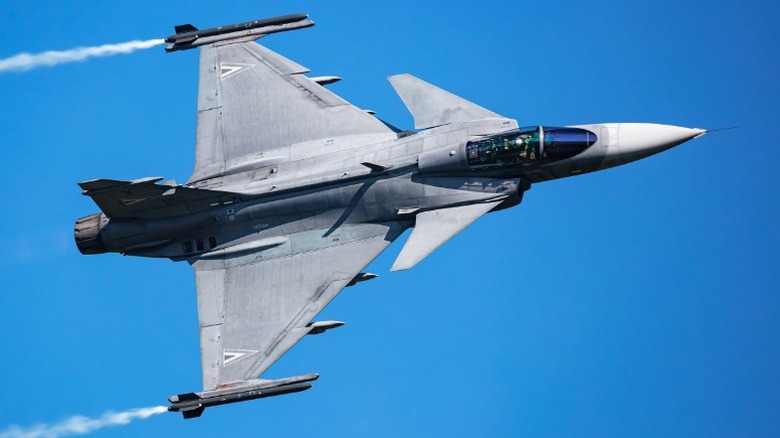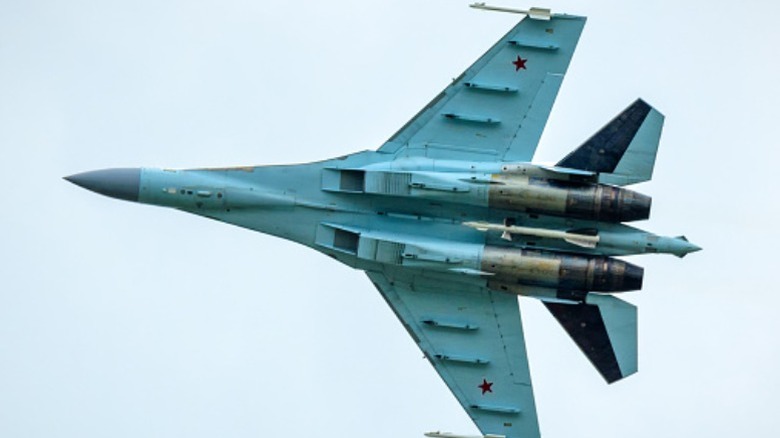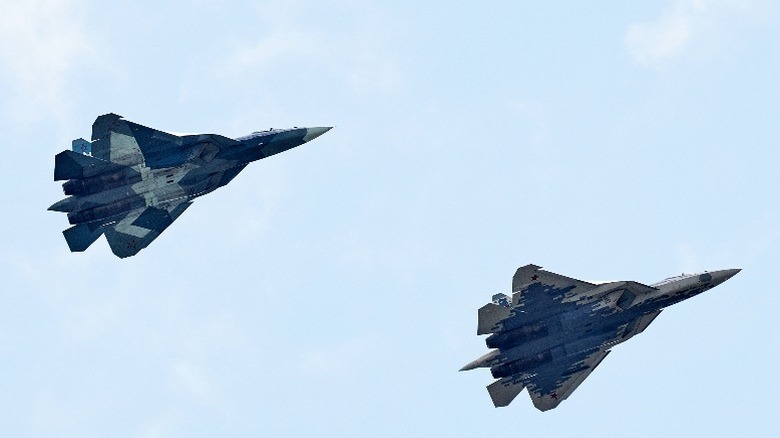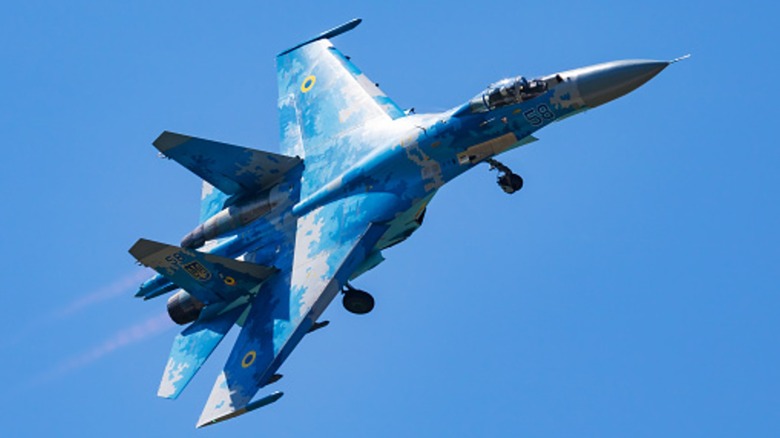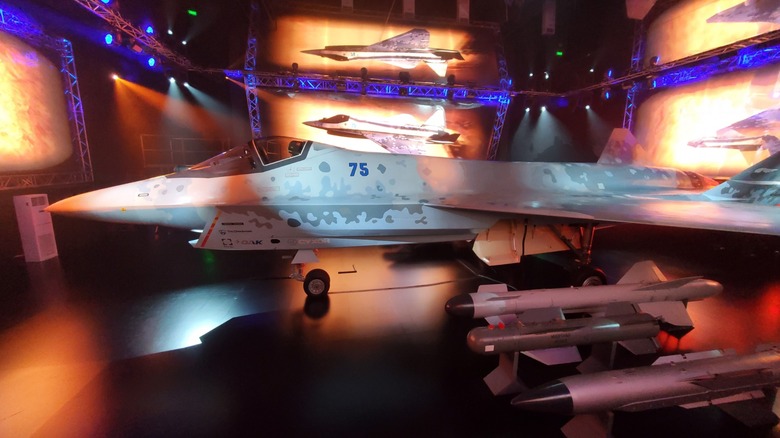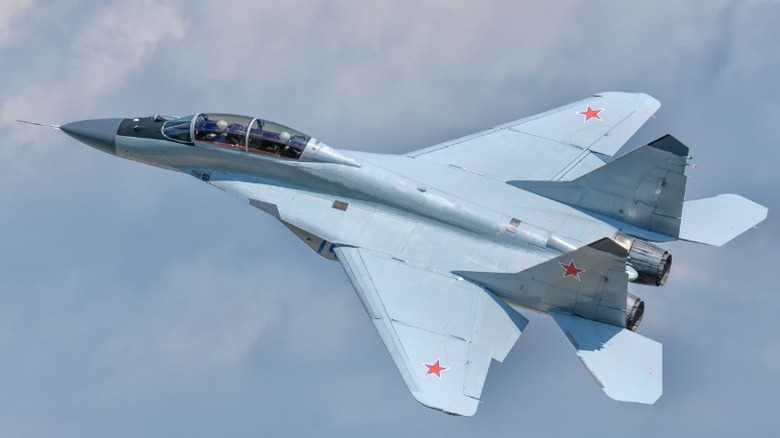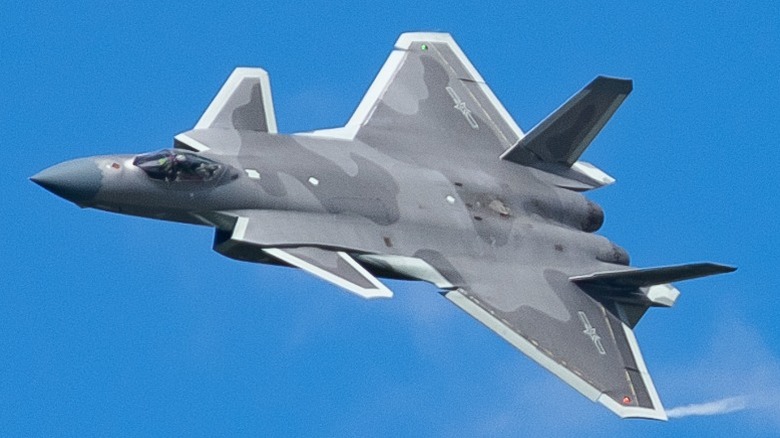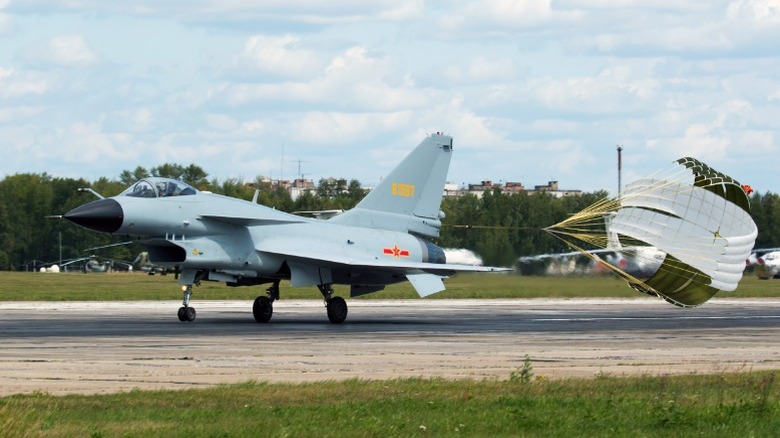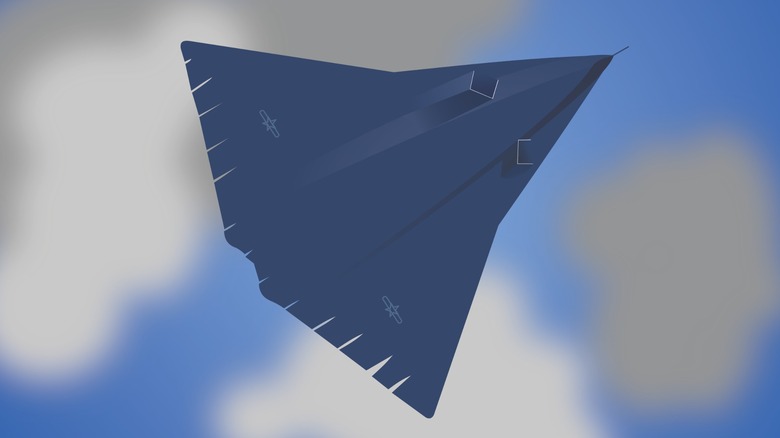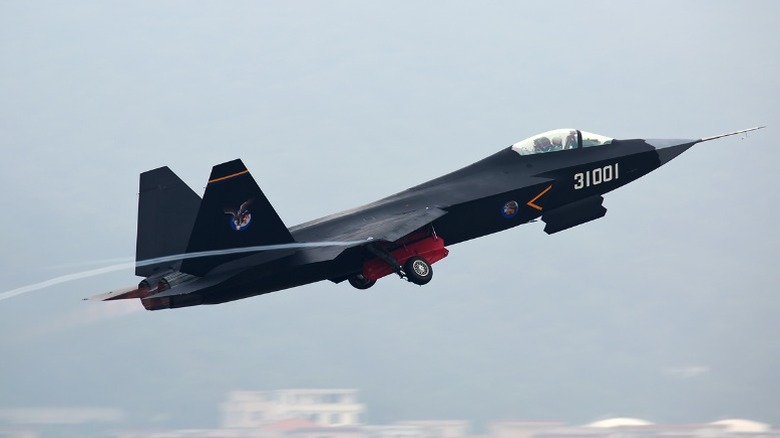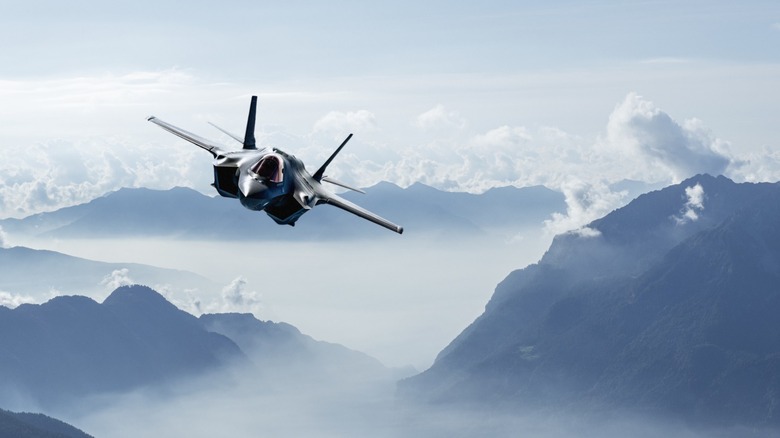17 Best Fighter Jets In The World Today
The skies over our planet are the domain of the fighter jet, the most terrifying and deadly predator the Earth has ever known. These marvels exist at the bleeding edge of science and technology and can take decades and billions upon billions of dollars to develop. They are the closest thing we've ever built to X-wings from "Star Wars," and in fact, experimental versions of these high-tech vehicles have often been mistaken for UFOs. Some are exclusive to a single powerful nation, while others are sold to allies to become mainstays of many different air forces.
Where once fighter jets were a separate breed of aircraft from bombers, many modern fighters take on numerous roles and are utilized for multirole capabilities. They are capable of everything from intense air-to-air dogfights to devastating bombing runs to air-to-ground missile strikes. Many integrate advanced computer systems and augmented reality helmets to give pilots as expansive a view of the battlefield as possible. Currently, the US, Europe, Russia, and China manufacture the bulk of the world's fighter jets, which are often then sold to allied nations.
While the race to build the best jet fighter in the world marches on, with nations throwing high percentages of their gross domestic profit into research and development programs, these are the best currently prowling the wild blue yonder. It's important to note that these fighter jets are not arranged with any particular preference, and are simply grouped by nationality.
F-35 Lightning II
Built for stealth and striking at an extreme distance, the F-35 Lightning II is one of the most advanced fighter jets in the sky today. Its design prioritizes low observability by incorporating a mirror-like shiny finish to disrupt both visual and radar detection.
Available in three different versions, the F-35A is the standard model, while the F-35B is capable of short take-off and landing, and is designed to operate from amphibious assault ships. Where Harrier jets are quite difficult to land vertically, the F-35B makes vertical landings much less tricky for pilots. The F-35C is meant primarily for aircraft carrier use, with longer wings that fold and offer increased fuel economy. The F-35 has a top speed of Mach 1.6, which is less than many other fighter jets operating today, but the F-35 compensates for this with its stealth capabilities and its unparalleled range of engagement.
The F-35 Lightning II is crammed with computing power, and controlled with touch screens. Pilots are equipped with a helmet-mounted display system that connects to the jet's electro-optical distributed aperture system to provide 360 degrees of visibility.
The high-tech nature of the F-35 lighting II makes it a pricey fighter jet indeed, starting at around $80 million, with an operating cost of over $40,000 per hour, though it's not as exorbitantly expensive as the F-22.
F-22 Raptor
First taking to the skies almost 26 years ago, the F-22 Raptor remains a terrifying predator in the U.S. Air Force. It's a particularly maneuverable aircraft, featuring thrust vectoring, meaning that it's able to manipulate the direction of its engines. The F-22 has a thrust-to-weight ratio of 1.26 at 50% fuel and 70,000 pounds of thrust. This gives it a top speed of Mach 2.25. This makes it one of the fastest jets currently in service, and combined with its maneuverability, the F-22 is particularly capable when it comes to air-to-air combat.
The F-22 maintains a stealthier profile than some other fighter jets without compromising on armaments by including three separate weapons bays. Like the F-35 Lightning II, the F-22 features an advanced augmented reality vision system for pilots.
The impressive combat capabilities of the F-22 come with the dubious distinction of being one of the most expensive fighter jets ever, costing over $143 million, depending on how the dollar value of the aircraft is figured. On top of this, it costs more than $80,000 per hour to operate. The high cost and focus on air-to-air combat have made the F-22 an unpopular jet with the U.S. military, as the U.S. has a greater need for fighter jets with multi-role capabilities, and the F-35 Lightning II is perfect for that purpose at a much lower price point.
F-15EX Eagle II
A new addition to the U.S. Air Force, the F-15EX Eagle II is the latest in a long and prestigious line of fighter jets manufactured by Boeing. The F-15 series of aircraft has among its accolades the distinction of never having been shot down in combat, and having taken out over a hundred enemy fighters. These kills have mostly been accomplished by Israeli pilots, and the F-15EX Eagle II adds to the capabilities of the previous F-15 with four more missile stations, as well as improved onboard computers and a fly-by-wire system.
Traveling at a staggering maximum speed of Mach 2.5, the Eagle II is the fastest fighter jet currently in operation. It's not stealthy and is made for bold and brash air-to-air combat, or devastating lightning-fast air-to-ground strikes.
The F-15EX Eagle II is much more economical than other concurrent U.S. fighter jets. It costs over $80 million each, and $27,000 per hour to operate, but it has a long life expectancy so that one F-15EX Eagle II will last roughly three times as long as an F-35 Lightning II.
F/A-18 Hornet
This venerable old fighter jet first flew in 1978, and production ended in 2018, but despite its age and the fact that no more are being built, the F/A-18 Hornet is still extensively deployed by the Navy and Marine Corps. It is expected to remain the Marine Corps' primary platform until they fully transition to the F-35, a process anticipated to be completed by 2030.
The F/A-18 Hornet is equipped with an M61A1/A2 Vulcan 20mm cannon, along with a wide array of munitions. It was the first all-weather jet fighter deployed by the U.S., capable of traveling at over Mach 1.7 and climbing to altitudes exceeding 50,000 feet. Each F/A-18 Hornet costs $29 million and is known for being particularly rugged and reparable. These fighters have been known not only to survive surface-to-air missile strikes but also to be quickly repaired and ready to fly again as soon as the next day.
F-16 Fighting Falcon
The success of the F-16 Fighting Falcon is undeniable, as it remains the most common military fixed-wing aircraft in the world today. This jet fighter was first introduced in 1976, and since then, over 4,600 of them have been built, with the F-16 Fighting Falcon still in production today. While it may seem relatively mundane by the standards of more modern aircraft, when it was produced, such revolutionary features as its high-visibility bubble cockpit and relaxed static stability design have kept it relevant to this day.
With its single engine, the F-16 can reach 1,500 mph and has a ceiling above 50,000 feet. It's equipped with an M61A1 20mm multi-barrel cannon with a capacity for 500 rounds and can be equipped with a wide variety of other armaments, from air-to-air missiles to air-to-surface munitions or electronic countermeasure pods. At between $14.6 million and $18.8 million (depending on the variant), affordability is definitely a factor in the F-16 Fighting Falcon's success.
Dassault F-4 Rafale
Named after a gust of wind, the Dassault F-4 Rafale is a French fighter jet designed especially for a high degree of maneuverability. This is a twin-engine multi-role fighter capable of operating from both carriers and land bases. The Rafale is a significant technological step forward from its predecessor, the F-3R, with improved connectivity including satellite communication and communication servers.
With a top speed of Mach 1.8 and a maximum altitude of 50,000 feet, the Rafale is competitive with other modern jet fighters. Its all-moving canards near the nose of the aircraft make it particularly agile at low altitudes. However, unlike many other modern aircraft, the Rafale isn't designed with stealth as a major goal, despite some stealth features. In many ways, the Rafale is a much more traditional sort of fighter jet.
The Dassault Rafale comes in single and dual-seat variants, and costs over $100 million, making it one of the more expensive fighter jets on the market, though it only costs $18,000 – $21,000 per hour to fly. This is in part due to maintenance optimization features that make it more economical to fly.
Eurofighter Typhoon
The Typhoon is a key NATO aircraft used throughout the EU and abroad. It's engineered to be a highly effective dogfighting craft. Its complex avionics system features such advanced techs as direct voice command input, so you can basically ask the airplane's version of "Alexa" to save you from incoming missiles.
Because this is a Nato plane, the Typhoon was designed and is produced in part by several European countries, though as you may not be surprised to hear, France dropped out of the program due to a disagreement over the design. Its maximum speed is Mach 2 and features forward canards like the Dassault F-4 Rafale to improve maneuverability. Also, like the Rafale, the Typhoon is not intended as a stealth aircraft.
This lack of stealth capability falls in line with the purpose of the Typhoon as a NATO fighter jet, as it's really more of a multi-million dollar airborne police car. It's intended for keeping the skies safe over member countries. Its cannons and other armaments are highly versatile, including its Storm Shadow and Brimstone air-to-ground missiles.
The Eurofighter Typhoon Costs only around $50 million for European nations within the EU, while buyers outside of this group need to shell out nearly three times that price.
Saab JAS 39 Gripen
A highly capable fighter jet manufactured in Sweden, the Gripen is powerful and widely used. Most importantly, the Gripen is remarkably cheap to operate (for a fighter jet), with an operating cost of only $4,000 per hour. It was originally designed for guerrilla warfare against Russia, the Gripen is purpose-built to be rugged and not need much maintenance. It can also take off from relatively short, crude runways, and is overall ideally suited to use in remote and isolated outposts.
The front canards can be used as an airbrake, and the jet has skid-resistant landing gear so that the Gripen can land on highways and shorter runways. The onboard self-diagnostic system enables it to be maintained by a ground crew of as few as six people, who can have it fueled and rearmed in as little as ten minutes. It's significantly lighter than other modern fighter jets, meaning it can change direction more rapidly.
The Gripen features reconnaissance pods for observing enemy forces, has a top speed of Mach 2, and is a true Viking warrior of the wild blue skies.
SU-35
The SU-35 is an older fighter jet that remains a staple of the Russian air force after more than three decades, as well as being used in China and other nations in Asia. It was created with the purpose of countering the American F-22 Raptor, and like the F-22, the SU-35 features thrust vectoring for improved maneuverability. It's capable of carrying a particularly large quantity of air-to-air missiles and is meant primarily for engaging enemy aircraft.
For the modern theater of war, the SU-35 is equipped with an advanced electronic warfare system, in particular, it has a powerful Irbis-E radar system, which can detect enemy aircraft at a range of over 400 km. Reportedly, it can also track stealth aircraft at a range of around 80 km.
With a top speed of Mach 2.25, the SU-35 is a blazing-fast fighter jet, and it's capable of operating at up to 60,000 feet. With a starting price of around $85 million, this isn't a cheap aircraft.
SU-57 Felon
This brand-new fighter jet finally entered service in 2020 after being in development since the 1970s. It uses unconventional "bionic" components to make for advantages such as increased stealth capabilities. There are only 12 in service, as far as we know, and Russia has limited its use to Russian airspace so as not to risk it being shot down. As such, it is restricted to long-range roles that keep its secretive and advanced technologies out of enemy hands.
The SU-57 utilizes thrust vector jets for heightened maneuverability and can fly at speeds up to Mach 2. This fighter jet is equipped with a laser defense system, which blinds incoming enemy missiles with laser beams to disrupt them and send them careening off-target. Its array of six radar dishes allows it to track 60 targets simultaneously. These radar dishes are spread out around the airframe, enabling it to detect these targets from practically any angle. The SU-57 has the longest supersonic range of any fighter jet, being able to fly beyond the speed of sound for over 1500 km.
The SU-57 may also be kitted out with miniaturized ballistic missiles that travel at hypersonic speeds.
Sukhoi Su-27 Flanker
Built as a response to the F-15 and F-14, the Sukhoi Su-27 Flanker still actively sees combat in the skies today. Though originally designed by Russia to counter the F-15 Eagle, it has since been adopted by other nations, including Ukraine. Many countries have Sukhoi fighter jets in their military, with the Su-27 Flanker standing out as a prominent example. Despite first taking flight in the '70s, the Su-27 Flanker continues to hold its own as a formidable presence on the modern battlefield.
The Sukhoi Su-27 Flanker can fly at an impressive Mach 2.35 and features a remarkably high ceiling of 59,000 feet. With a 30mm cannon and a range of versatile munitions, including cluster bombs (as well as the more conventional variety), homing air-to-air missiles, and unguided air-to-ground rockets, it's no surprise this aging fighter jet remains widely used today. The cost of the Su-27 Flanker starts at around $41 million, though this number can vary greatly based on a number of factors, including the specific configuration of the aircraft.
Sukhoi Su-75 Checkmate
While Russia showed off this advanced new fighter jet in 2021, it is not yet in production. The very nature of what this jet actually is remains murky, and the actual cost to manufacture one is hard to pin down. While it was initially predicted to cost as little as $25 million per plane, those estimates have likely gone out the window. What we do know is that it features a diverterless supersonic inlet and internal weapons bays, which will reduce its radar signature and make it relatively stealthy. It is expected to reach speeds of Mach 1.8, if not Mach 2, and have a range of 1,864 miles.
The first flight of the Su-75 Checkmate was originally scheduled for 2023 but has faced repeated delays. As of now, it is expected to finally take to the skies in 2025 and enter service as early as 2026.
MiG 35
This new and highly capable fighter jet is fearsome, but not yet widely used due to production issues within the company that developed it. The MiG 35 can track 30 different targets, and engage 6 at a time. It accomplishes this with two optical location systems, one forward on the aircraft to look for air targets, and one under the fuselage that looks for surface targets. However, while capable, the MiG 35's targeting system is at a disadvantage to modern equivalent aircraft. While the MiG 35 can track up to 30 targets at a time, Russia's own SU-57 Felon doubles that number. Plus, there are doubts as to whether the Russian military can field the same network of modern support that American and Chinese militaries can.
The MiG 35 features thrust vectoring in two planes for increased maneuverability, and has a maximum speed of Mach 2.25. It's armed with a 30mm cannon and can be fitted with a variety of missiles and bombs.
Chengdu J-20 Mighty Dragon
Not much is known about the Chengdu J-20 Mighty Dragon, a highly secretive fighter jet. It's designed to compete with modern U.S. jets, though whether it would actually measure up to them in a dogfight is difficult to say. Likely it's not intended for such fights since it doesn't appear to possess the rotary canons necessary for these engagements. Instead, it utilizes missiles for long-distance fighting. It features a sensor system and augmented helmet display like high-tech American fighter jets, and the J-20 possesses stealth capabilities.
The Chengdu J-20 has a maximum speed of Mach 2.25, and a range of 4500 kilometers. Later models of the J-20 feature super-cruise, meaning they can travel at high speed without afterburners. It's a fifth-generation fighter, and there is speculation that it's based on stolen plans for the F-22 Raptor. It costs between $100 million and $120 million to produce, making it one of the more expensive fighter jets.
[Featured image by N509FZ via Wikimedia Commons | Cropped and scaled | CC BY-SA 4.0]
Chengdu J-10 Vigorous Dragon
The first fighter jet produced by China, this is the primary aircraft used by the Chinese air force. With a maximum speed of Mach 2.2, it's nearly as fast as the J-20 and was originally created to counter Soviet fourth-generation fighters. After the collapse of the Soviet Union, it was adapted into a multi-role jet fighter as the need for air-to-air specialized craft declined.
The J-10 Vigorous Dragon is equipped with pulse doppler fire control radar, which can track ten targets and engage four of those targets simultaneously. It comes in one and two-seater varieties, and costs vary widely based on configuration. Unlike the J-20, the J-10 is equipped with a single barrel 23mm cannon for air-to-air combat. That's in addition to its radar and infrared homing missiles, as well as guided bombs. It costs between $40 million and $65 million and has been sold to other nations such as Pakistan.
Chengdu J-36
Very little is known about the J-36 — even the name isn't rock solid as it may also be called the JH-XX. The designation "J-36" is derived from photos of the aircraft showing the number 36, while "JH-XX" is based on the assumption that this is a version of a prototype jet previously known by that designation. It is possible that the J-36 is the production version of the JH-XX, though, of course, all this is still speculation. What we do know is that this is China's 6th-generation fighter/bomber and that it's clearly designed with stealth in mind. From a purely aesthetic standpoint, the J-36 may be among the coolest looking fighter jets – that is, if we can ever get a really good look at it.
From photos captured of this secretive aircraft, its profile appears to demonstrate a clear intent to evade detection by air defenses through the minimization of its radar signature. To facilitate this, weaponry is concealed in internal bays, creating a sleek, stealthy form typical of such aircraft. The J-36 also appears to have three engines, which could make it an extremely fast and maneuverable aircraft, However, this might also mean that the fighter jet could have a more severe thermal signature than would typically be desirable.
Shenyang FC-31
Another highly secretive Chinese fighter jet, the FC-31 (also referred to as the SAV J-31) is very similar to American 5th-generation fighters. This is a midsize stealth fighter, without exterior weapons which would compromise its stealth capabilities. It's been spotted hanging out on gigantic mockups of aircraft carriers in China, leading to speculation that the FC-31 is intended to operate within the Chinese navy. It's likely that the FC-31 costs around $70 million to produce.
The FC-31 front end bears a strong resemblance to the F-35 Lightning II, while its tail is similar to that of the F-22 Raptor. Like other modern Chinese fighter jets, this resemblance is likely due to a tendency for this nation to pattern its warplanes based on U.S. designs. The FC-31 has a top speed of Mach 1.8 and is heavier than the F-22. It's likely too heavy to launch off of older Chinese carriers with their ski-jump ramp design, but China recently deployed its first flat-deck carrier with an electromagnetic launcher that will allow this jet to launch fully loaded.
Why we picked these fighter jets
Ever since the Messerschmitt Me 262A Schwalbe took to the skies and made history by being the first jet fighter to see combat in 1944, we have seen many such jet-powered aircraft come and go. They've evolved dramatically over the years as technology marches ever onwards, and so the best jet fighters of one era may not remain dominant in the next. However, jet fighters are long-lived, and while the latest and greatest may get all the headlines and funding, models developed 50 years ago may still remain the workhorses of any given military. This is especially true given that most nations do not develop their own fighter jets, and those that do tend to withhold their very best for their own use.
We selected the jets listed here from fighters that are battle-tested and currently see widespread service, as well as those on the bleeding edge of development which are only just now entering the public eye.
